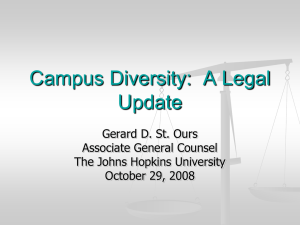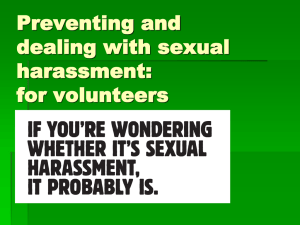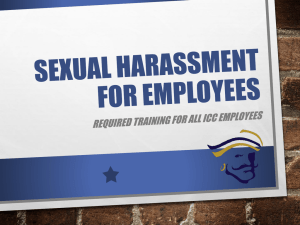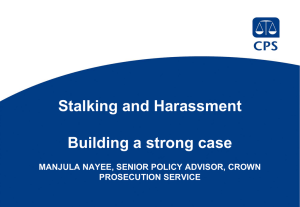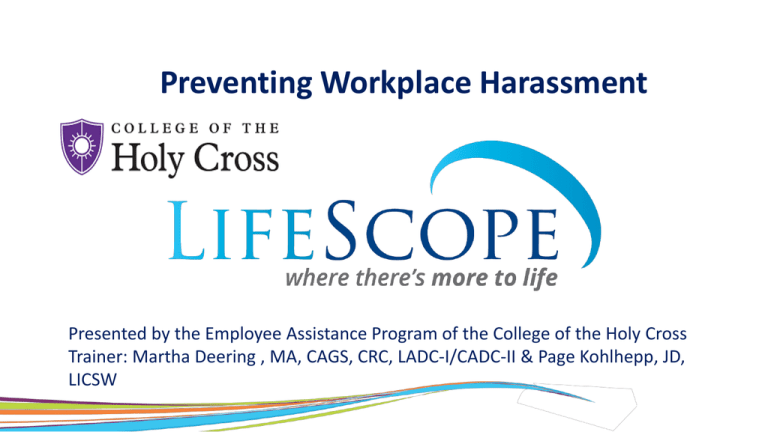
Preventing Workplace Harassment
Presented by the Employee Assistance Program of the College of the Holy Cross
Trainer: Martha Deering , MA, CAGS, CRC, LADC-I/CADC-II & Page Kohlhepp, JD,
LICSW
Scope of Course
•
•
•
•
Workplace harassment
Inappropriate conduct
Sexual harassment
Bullying
What Will We Learn?
• Recognition
o
Illegal harassment vs. inappropriate conduct
• Prevention
o
•
•
•
•
All types of harassment and inappropriate conduct
Know it when you see it.
Know what to do about it.
Understand your role.
Know how and when to react to it.
What is Workplace Harassment?
Conduct that degrades or shows hostility or aversion toward
an individual because of his or her protected status, or that
of his or her relatives, friends, or associates, and that:
(1) Has the purpose or effect of creating an intimidating, hostile, or
offensive work/education environment;
(2) Has the purpose or effect of unreasonably interfering with an
individual’s work/academic performance; or
(3) Otherwise adversely affects an individual’s
employment/education opportunity
Workplace Harassment
• Must be subjectively and objectively offensive to a
reasonable person
• Must be severe and pervasive
• Employee/student need not communicate objection to
demonstrate its unwelcomeness. Employee’s/student’s
rejection of or failure to respond positively may
demonstrate unwelcomeness.
Workplace Harassment: Categories
• Quid Pro Quo (usually involves power differential):
o
o
o
o
o
Behavior is unwelcome
Protected group/status
Subjected to unlawful harassment based on sex or other
protected status
Harassment affected aspects/terms of
employment/education – i.e., “fired”, “failed”
Submission is used:
• As term of employment /education
• To make decisions that affect the employee/student
Workplace Harassment: Categories
•
Environment (Hostile Work Place) [general]
o
Environment is tainted with sex, gender based, and/or other
protected status discrimination such that the terms,
conditions or privileges of employment/education are
adversely affected.
• Unwelcome in nature
• Gender or protected status was the cause of harassment
• Had the effect/purpose of creating an intimidating, hostile,
humiliating or sexually offensive work/education environment
• Interfered with work/education; altered the terms or conditions
of employment/education
Unpleasant Behavior is not Always
Unlawful Discrimination
• Individuals often use the phrase “hostile environment” to
describe any condition they find unpleasant.
• Law does not require work/school to be an “idyllic
retreat”.
• Threshold questions under law:
o
o
Are all employees/students treated consistently?
If conditions are inconsistent, is inconsistency related to
protected characteristic, such as race or sex?
Why Is Harassment Prohibited?
•
•
•
•
•
Legal obligation
College values, policies
Reputation
Morale
Productivity
Legal Basis
State and federal law prohibits employers from
discriminating against employees based on their
protected status/group:
Title VII of the Civil Rights Act of 1964 and 1991
Age Discrimination in Employment Act of 1967 (ADEA)
Americans with Disabilities Act of 1990 and 2008 (ADA)
Genetic Information Nondiscrimination Act of 2008(GINA)
Title IX of the Education Amendments of 1972 – recently
updated – check your policies
Civil Rights Act of 1964/1991
• Title VII imposes a duty on employers to guard
against harassment and to take effective steps when
a violation of the Act occurs, such as proven,
effective means by which an employee can report
complaints.
• Prompt action: hours, rather than days, and days,
rather than weeks.
• Sufficient awareness of the civil and private rights of
the accused.
Title IX
• Title IX of the Education Amendments of 1972 (revised
2014) prohibits discrimination on the basis of sex in
education programs and activities receiving Federal
financial assistance. Sexual harassment of students can
be a form of discrimination prohibited by Title IX.
• Requires written policies and wide dissemination of
policies, training, specialized reporting
• Applies to everyone on campus
• Forbids retaliation
• Requires Title IX Coordinator
Student-to-Student Issues
• Students of all ages
• Wide range of physical and verbal behaviors
• School officials often uncertain when and how to
respond
• School Districts & Higher Education are being held
responsible
Protected Categories Include:
• Gender
• Gender identity/
Transgender (state)
• Sexual orientation (state)
• Genetics
• Race
• Religion
• Color
• Ethnicity
• Marital/pregnancy status
•
•
•
•
•
Age
Disability
National origin
Military or veteran status
Perception of any of the
above
• Massachusetts Criminal
Harassment Law
Discrimination Includes . . .
• Treating employees/students differently with respect to
any term or condition of employment/education based
on their protected characteristic.
• Harassing employees/students or allowing
employees/students to be harassed based on their
protected characteristic.
Sources . . .
•
•
•
•
Employee/Student Manual
Policies: Sexual Harassment, Workplace
Harassment, Bullying, Respectful Workplace, etc.
Human Resources Department
Deans, managers
Why Does Harassment Occur?
•
Not about sex, religion, race, etc.
•
Abuse of power
•
Intimidation
Respectful Workplace Policy
• “Holy Cross Prides itself as a community [where]…
each individual is entitled to respectful treatment from
others in an environment free from harassment. …
The goal of this policy is … to transcend legal
considerations and appeal to principles governing
honorable behavior in a just and principled community.
… Holy Cross seeks to build a community marked by
freedom, mutual respect and civility…”
Holy Cross Sexual & Discriminatory
Harassment Policy
• “Each person has the right to work and be educated in an
atmosphere that is free from discrimination and
harassment… This policy is neither designed nor
intended to limit the College’s authority to discipline or
take remedial action for conduct which is deemed
unacceptable, regardless of whether that conduct
satisfies the legal definition off harassment.”
Where Does Bullying Fit in?
• Bullying may/may not be inappropriate conduct.
• Inappropriate conduct that may rise to the level of
illegal conduct.
• Core concept: Repeated, persistent, unwelcome,
intrusive, health-threatening behavior of one person
by another in work or work related circumstances.
• Risk of being bullied: 1 in 6
o
Issues: No specific laws, few policies, denial, societal
acceptance
Bullying Behaviors: Examples
• Making threats about job security/grades with no
basis
• Constant criticism, especially unwarranted
• Deliberately undermining through overloading,
refusal to make equipment/information available
• Silent treatment, isolation
Bullying Behaviors: Examples continued
• Making up rules “on the fly”
• Starting or failing to stop destructive
rumors/gossip
• Different rules for target
• Screaming
• Post complaint retaliation
MA Criminal Harassment Law
G.L. c265, s43A
• Willfully and maliciously
• Pattern of conduct or
series of acts directed at a
specific person
• OR one act that in force,
threat or distress causes
a person to involuntarily
engage in sexual relations
• Seriously alarms that
person and would cause a
reasonable person to
suffer substantial
emotional distress
• Includes acts committed
by mail, telephone,
telephonic device, email
and internet
An Act Relative to Harassment Prevention
Orders (G.L. c. 258E)
A new law that allows victims of stalking, sexual assault
and/or harassment to obtain a harassment order against
his/her perpetrator.
• A victim is not required to pay a filing fee.
• A victim does not need legal representation.
• Victim must demonstrate “harassment”.
• While obtaining the harassment order is a civil process, a
violation of the harassment order is criminally enforceable.
• No relationship with perpetrator is required.
What is Sexual Harassment?
• Unwelcome sexual advances, requests for sexual favors,
and other verbal or physical conduct of a sexual nature
when:
• (a) Submission to such conduct is made either explicitly
or implicitly a term or condition of employment or as a
basis for employment/education decisions or
• (b) Such requests or conduct have the purpose or effect
of unreasonably interfering with an individual’s
work/academic performance by creating an intimidating,
hostile, humiliating, or sexually offensive work/academic
environment.
Some Disturbing Statistics
• 1993 Louis Harris & Associates study for the American
Association of University Women (AAUW).
• 1,632 field surveys - students, grades 8 -11, from 79 school
systems across the U.S.
• 81% had experienced some form of sexual harassment.
• First sexual harassment experience was most likely to occur
in the middle school/junior high school years.
• The two most common forms of harassment were:
o 1) sexual comments, jokes, gestures or looks
o 2) being touched, grabbed, or pinched in a sexual way.
Disturbing Statistics
• 2064 public school students
• 83% of female students reported being sexually harassed
during school career
• 79% of male students reported being sexually harassed
during school career
• A recent similar survey of college students still showed
almost 70% of students experienced some form of sexual
harassment.
~ 2001 Louis Harris & Associates study for the American Association of
University Women (AAUW).
Statistics
• EEOC reports:
• 15,000 claims of sexual harassment/year
• 40-60% of women experience sexual harassment in
the workplace
• 16% of men report sexual harassment in the
workplace
Levels of Sexual Harassment
•
•
•
•
•
Gender harassment
Seductive behavior
Sexual bribery
Sexual coercion
Sexual imposition
What Is Involved in Sexual Harassment?
• The harassment can be physical (touching, kissing),
verbal (lewd jokes, sexual comments), and visual
(pornographic materials).
• The conduct must be sexual in nature.
• The conduct must be severe and/or pervasive.
• The conduct must be unwelcome. NOTE: An
employee/student need not communicate objection to
the conduct to demonstrate its unwelcomeness.
• The conduct must be both subjectively and objectively
offensive.
• Can occur between or within genders.
What Is Involved in Sexual Harassment?
• Conduct need not be
motivated by sexual desire
to be actionable.
• Acceptance/submission is
made explicitly or implicitly
a term or condition of
employment/education.
• Individual’s response to
conduct is used as a basis
for decisions impacting the
employee/student.
• The harasser: supervisor,
supervisor in other area, coworker, professor, student,
contractor, manager, nonemployee
• Victim does not have to be
the person targeted
• Economic injury to the
victim not required
What Determines If Conduct Is
“Unwelcome”?
• When the target says so!
• Is there an equal level of initiation and participation
in the behavior?
• Can it be fairly said that there is equal economic
power between the people involved?
Recognizing Harassment
• VERBAL……
• Telling sexual stories or jokes and using “four-letter”
obscenities.
• Using such terms as sweetie, doll, honey, dearie, babe.
• Making sexual comments and innuendoes about a
person’s body or appearance.
• Probing into a person’s sexual experience or preferences.
• Making suggestive sounds or whistling at a person.
• Stereotyping (older people lack energy, “they” are all
stupid)
Avoiding Offensive Speech/Action
• Would you say/do it in front of your spouse/domestic
partner, parent or child?
• Would you say/do it if you were going to be quoted in
the paper?
• Would you say/do it the same way, or behave the
same way – regardless of the other’s protected
status?
• Why does it need to be said/done at all?
Nonverbal...
• Leering and ogling suggestively at a person
• Following a person or blocking their way
• Showing a sexually explicit picture, cartoon or other
visual
• Making suggestive gestures or body movements
• Sending unwanted notes or other written material
• Giving unwanted personal gifts
Physical...
• Touching a person’s clothing or hair
• Massaging a person’s neck or shoulders
• Leaning over, standing too close to, or brushing up
against a person; invading their space
• Kissing, caressing or pinching a person
Effects of Harassment, Sexual
Harassment & Bullying
Psychological
Effects
Physiological
Effects
Career-Related
Effects
Depression, anxiety,
shock, denial
Anger, fear,
frustration
Insecurity,
embarrassment,
betrayal
Confusion,
powerlessness
Shame, selfconsciousness
Guilt, self-blame,
isolation
Headaches
Lethargy
Gastrointestinal
distress
Dermatological
reactions
Weight fluctuations
Sleep disturbances,
nightmares
Phobias, panic
reactionsSexual
problems
Decreased job
satisfaction
Unfavorable
performance
evaluations
Loss of job promotion
Drop in academic or
work performance due
to stress
Absenteeism
Withdrawal from work
or school
The employer….
Responsibility for
Harassment
Who’s Liable?
Managers/administrators,
Deans, department heads,
boards committees, etc.
The Harasser….
employees, managers,
faculty, students, supervisors,
visitors, independent
contractors, etc.
Third Parties….
anyone aiding, abetting,
inciting, compelling, coercing;
or deliberate indifference
Personal Liability
• The law holds individuals, as well as employers,
liable for discrimination.
• Holy Cross policies hold individuals responsible.
• To determine if you acted in good faith, did you:
•
•
•
•
Put the College’s interest ahead of individual interest?
Follow College policy?
Obtain your supervisor’s approval of a course of
action?
Consult College experts and follow their advice?
General Guidelines for Dealing With a
Complaint : Supervisors
• Listen to the complaint carefully without judging.
Explain the process.
• Protect privacy.
• Document everything.
• Allegation/claim ≠ fact
• For violations, contact:
o
o
o
Supervisor
Director of Human Resources X3391
Director of Administrative Services/Affirmative Action
Officer X3423
General Guidelines - continued
To file a complaint (formal/informal), contact:
• Against students:
o
Vice President for Student Affairs/Dean of Students
X2414
• Against teaching faculty:
o
Vice President for Academic Affairs/Dean of the
College X2541
• Against administrators:
o
Appropriate divisional contact – see policies (page 30)
for more details
General Guidelines for Dealing With a
Complaint: Harassment Officer
• Listens to the complaint
carefully without judging.
• Explains the process.
• Protects privacy.
• Interviews accused party
and relevant others.
• Determines credibility of
allegation and takes
appropriate action.
• Documents the entire
process. Does follow up.
• Checks Harassment
Policies for specifics.
• Even where an
organization may not be
directly responsible for all
harassing conduct, they
are required to take
appropriate responsive
action.
What Can The Target Of Harassment Do?
• Tell harasser to stop!
• Be sure that you know your policies and
procedures.
• Report the harassment immediately to one of
your Harassment/Bullying Officers.
• Talk to a friend.
• Document everything:
o
Personal log, evidence, record of action taken,
phone calls, witness statements
What Can The Target Of Harassment Do?
• Know your rights under your policies, your state’s
harassment/sexual harassment law, and the federal
laws prohibiting harassment/sexual harassment.
• Massachusetts Criminal Harassment (MGL c265,
s43A) and Harassment Prevention (MGL c.258E)
laws.
What Can The Target Of Harassment Do?
• If warranted, file a complaint with:
o
o
o
U.S. Equal Employment Opportunity Commission
(EEOC – 300 days) JFK Federal Building, 475
Government Center, Boston, MA 02203 (800)669-4000
Massachusetts Commission Against Discrimination
(MCAD- 6 months), 1 Ashburton Place, Boston, MA
(617)994-6000
Office for Civil Rights, US Dept. of Education, 8th floor, 5
Post Office Square, Boston, MA 02109-3921
(617)289-0111
What Can We All Do to Prevent Harassment?
• Respect differences.
• Communicate concerns.
• Never take the position that the anyone should
simply learn to cope with or ignore the harassment!!
Situations
1. A female employee wears tight T-shirts, low cut jeans
and jeans with revealing holes to work; some of her
male peers make sexual comments and jokes about
her.
2. A group of employees consisting of two women and
four men have an on-site celebration at the end of the
work day to celebrate a group member’s birthday. One
of the men tells a joke with sexual overtones.
Everyone laughs except one of the women, who is
quite offended. When she says so, everyone tells her
she is “too uptight” and she needs to “lighten up.”
3. An employee who is an immigrant from another country has
reported that a group of employees consistently makes
broad generalizations and uses phrases, the least offensive
of which is, “You people,” when addressing him. He has
asked them to address him by his name on several
occasions.
4. A student uses his/her cell in public campus locations for
graphic personal conversations about his/her intimate
relationships. These conversations can be overheard by
employees, students, and visitors.
5. An employee, new to the University, complains to a
supervisor that another employee has been leaving
suggestive notes and cartoons in his locker and in his
work area. He states that he doesn’t want to involve
Human Resources or upper management, and that he
can handle the situation.
6. Jill and Mike, work study students, have jobs in your
area. Both believe the manager treats them differently
than the rest of the staff. The manager constantly points
out their mistakes or criticizes them, while leaving alone
others who make as many mistakes. The manager has
yelled profanities at them in front of staff, students, and
the public.
7. Josh was overweight as a child but is now in really
good shape. Lori, his co-worker has said four times
that he has a very nice butt.
8. A female employee confides in you that her new
supervisor yells at her, leans over her, frequently tells
her she is useless. Today, she learned that this
supervisor has had similar behaviors with other
employees, as well as students.
9. In a faculty lounge, a faculty member reportedly makes
derogatory remarks about gays and lesbians, and has
denounced gay marriages as “unnatural” and “against
the laws of nature.”
10. Jim, a student intern, complains to the director that
Hector, one of the supervisors, periodically rubs against
him, simulating sex with his clothes on. Hector has done
this with many of the young staff, both male and female.
The director takes no action and says, “Oh, it’s just
hazing, it’s just teasing, you can’t take it seriously. He
does this with everyone.”
Always available. Always confidential.
800-828-6025
www.LifeScopeeap.com
Username: holy cross Password: guest

